Creating Viral Content: 17 Tips To Get Your Content Noticed

Seth Godin, the famous marketing guru, once said, “Ideas that spread, win.”
Over 5 billion people are online today.
When it comes to success with content marketing, you need to ask yourself: How many pieces of content are put online every second and how many of them go viral, and get seen by millions?
Many make the attempt, but only a tiny percentage achieves it.

So what then is the secret to maximizing your chances of achieving content that truly goes viral? Or, at a minimum, helping it to get seen and shared by more and more people with each campaign or post leading to growth in your leads, sales, and profits??
There’s no perfect formula, but, today I’m giving you 17 effective tips to increase the odds of your content going viral.
Here’s a preview of some of the tips (these links are clickable, so you can jump to one that piques your interest).
- Viral Content Tip #1: Study What Has Gone Viral in the Past
- Viral Content Tip #4: Tools Can Help — Use These To Go Viral Faster
- Viral Content Tip #8: Evoke the Right Emotion
- Viral Content Tip #11: You Need a Hook
- Viral Content Tip #14: Make It Relatable and Genuine
- Viral Content Tip #17: Failure Is The Secret To Success
One viral article can dramatically grow your business’ dramatically. For instance, I would estimate that just one of our most viral articles is responsible for at least $500,000 in revenue in recent years, not to mention 1000s of email lead optins.
So if you take action on these tips and you’ll have a much better chance at viral (including ongoing, self-sustaining) visibility.
All right, here’s tip #1.
In a rush? Grab a copy of this article to read anytime, anywhere. Download this article to quickly reference for viral inspiration. Click here to download it now.
How To Create Viral Content Tip #1: Study What Has Gone Viral in the Past
Steve Jobs said (and paraphrased Picasso), “Good artists copy, great artists steal.”
Start with what has worked for other people. Pioneers get arrows shot into their backs. You’re going to fail a lot. Get your results sooner by copying what works.
For example, back in the day, marketers considered the Skyscraper Technique an effective marketing strategy. So we did this for a few articles (like “The 9 Best Link-building Strategies”) and it worked. They got thousands of views and we grew our email list. Only then did we venture into creating original content.
The skyscraper technique is where you find a good piece of content and make it bigger and better. Then you get anyone who is already linked to the original article to link to your better article instead.

It’s a bit sneaky, but it’s also just business.
Then the idea is if someone sees two similar posts on Google search, they will choose the bigger and better one. For instance, if you saw “13 Tips To Get Your Article To Go Viral” and “17 Tips For Viral Articles,” which one are you going to click on?
There are also many websites you can check out to see what has gone viral.
- Buzzfeed
- Upworthy
- Littlethings.com
- Ranker.com
- Twentytwowords.com
Many of these websites have click-worth titles that you can learn from.
For example, you could go onto Buzzfeed and Ranker and see how their headlines capture audiences. You can clearly see patterns on what type of content and headlines get the most clicks.
Sometimes the best way to get started is to take what works and build on it. Don’t reinvent the wheel on your first try.
How To Create Viral Content Tip #2: The Viral Loop Vs Viral Marketing — Which Is Best?
The difference between the viral loop and viral marketing is that the viral loop is about customer acquisition, and viral marketing is about brand awareness.
Here is how a viral loop works:
- You get a customer
- You offer that customer an incentive to share their experience with friends
- The customer sees the incentive as valuable, so they share
- The friends see and trust the message and become new customers
- The cycle repeats
Basically, it’s like a referral program. You tell your friends to use the product you like, and get rewarded. Creating a viral loop to get more customers is great, but it takes time and probably not what you’re looking for if you’re reading this article.
You want to use viral marketing.
Viral marketing is any marketing tactic that encourages “rapid natural online sharing and accelerated word of mouth.” Creating a viral marketing campaign will get your brand way more exposure in a short period of time.

Many companies opt for a paid advertising campaign to start the ball rolling. Hopefully, the word of mouth sharing takes over and you can cut back on spending. Then the campaign pays for itself.
What you want to do is create an ad for your company without it being an ad. It should be something that is sharable that has your brand on it. Here are some examples.
The Blair Witch Project

Possibly the best viral campaign of all time. This horror movie had a budget of only $60,000. But because of viral marketing, they raked in over $260 million dollars at the box office. It worked because they used superb storytelling that made the movie seem real.
BlendTec
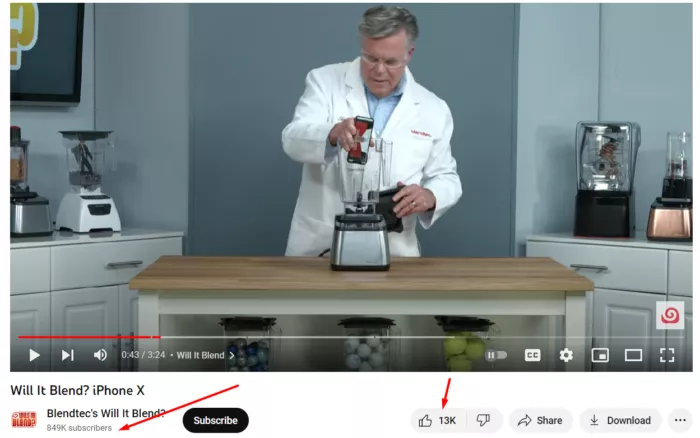
BlendTec created a fantastic viral marketing campaign with this hilarious video. It worked because they made a boring product fun. How do you get people talking about your boring blender? See what stuff it will blend.
And like, how much money did this cost to make? Not very much. Almost a million subscribers out of it though.
That’s also a good lesson on finding your unique selling proposition (USP) that your target audience will love…
How To Create Viral Content Tip #3: Know Your Target Audience So You Can Create Aligned Content
A McKinsey study shows that ads tailored to clients’ needs can increase ROI up to 8 times and lift sales by at least a factor of 10.
If you know your audience and can create content that speaks to them, you can turn that into profit.
That’s exactly what Shedd Aquarium in Chicago did with they’re target audience during COVID.
During the first lockdown, the Shedd Aquarium had an idea that they thought would perk up their fans. Fans who they knew were wrestling with the lockdown anxiety.
To bring some happiness to their news and social feeds, they created and shared a video of Wellington the penguin exploring the aquarium and meeting other animals at Shedd.

The original post received 3.7 million views on Twitter alone and more on YouTube. It also kick-started a viral “Penguin Tour” campaign, with more videos of Wellington interacting with other animals. Each video was a hit.
Shedd Aquarium knew their target audience was suffering at home, so they made these videos to warm their cold Covid hearts. And it worked. They went viral and got lots of new subscribers and probably customers (when the aquarium opened up again).
Just what the doctor ordered for people stuck inside during Covid.
What if you don’t know your target audience?
Well, then I would suggest gathering as much information as possible.
You can survey your audience to get these answers.
- Survey Your Email List: If you already have email subscribers, then you have a group of people who like your content. Survey them to find out what they all have in common and create content based on that.
- Survey On Social Media: If you don’t have an email list yet, you can create on on social media very easily. Not only will you get answers on what to create, you’ll get lots of reactions and comments. People love surveys.
Here are some questions to ask to find your target audience:
- What is your age range?
- What is your gender?
- What is your education level?
- Where do you live?
- What is the likelihood of you recommending our brand to a friend?
- How long have you been a customer?
- What social media channels do you use most often?
- What problem does our product/service solve for you?
- What is your profession?
- What are your hobbies and interests?
- Where do you spend your free time?
- What are your biggest challenges?
- What is most important to you?
- Where do you go for information?
- How do you like to make purchases? Online, or in-store?
- How would you rate our brand in comparison to our competitors?
Once you have a general idea of who your target customers are, you can create content that most of them will enjoy and share.
For example, if your target audience is younger, on TikTok, likes extreme sports, and can’t find thick enough kneepads, you know what content to make and where to publish it.
How To Create Viral Content Tip #4: Tools Can Help — Use These To Go Viral Faster
Going viral means big business. Therefore, you can now find many tools to help you achieve virality (exposure, backlinks, clicks, likes, sales, etc.).
Here’s a list of some tools you can use and what they do:
- Tumblr: Tumblr is a microblogging platform for sharing photos, music, videos, links, quotes, GIFs, texts, and other multimedia. Use this to find what is trending. 78% of posts on Tumblr are photos, so if you’re looking for viral photos, head here.
- TrendSpottr: TrendSpottr uses predictive intelligence to spot emerging trends based on data. See what is trending and make content around it. TrendSpottr predicted “Gangnam Style” to become a hit. It went on to become one of the most viewed videos on YouTube.
- OpenLinkProfiler: This tool lets you analyze the links of any website for free. Whichever content has the most links is getting shared the most, and you can use this info to model your own strategy and brainstorm similar topics.
- Alltop: Alltop gives you the headlines from popular topics around the web and is sorted alphabetically for easy searching. Find viral trends and topics. This is an easy site to copy what is trending and use it.
- Headline Analyzer by CoSchedule: This tool helps you create an awesome title for your content. Learn how to write the optimal headline here. Try to add numbers and value in your headlines.
- Canva: A Buzzsumo study says posts with images are twice as likely to be shared as those without, so enhance the images for your content with the Canva image editor.
- Buffer: Buffer allows you to manage various social media accounts from a single interface. Make sure all your content has a chance to go viral by efficiently posting on all your best platforms when people are most active.
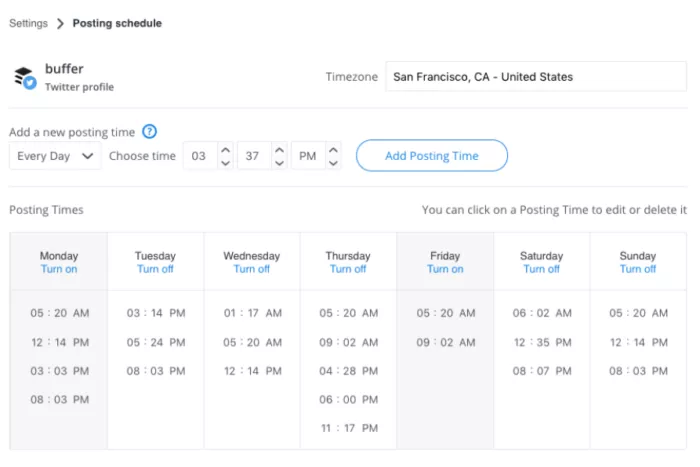
Great news… Growbo has gone freemium! Delegate your marketing in only a few clicks—with no contracts and no hiring headaches. It’s project management software with a team of digital marketing professionals at your fingertips. Click here to sign up for a free, hands-on demo of our new freemium option today.
How To Create Viral Content Tip #5: Choose the Right Format
Once you have identified your target audience, you will want to publish content they find most interesting (shareable). You can choose from several formats:
- Articles
- Listicles
- Infographics
- Interactive Content
- Animation
- Videos
…Or other more specific types like issuing challenges, podcast episodes, etc.
Here is some data on the type of content that is most likely to go viral:
- List posts are heavily shared, with an average of 218% more shares than “how to” posts and 203% more shares than infographics.
- Content over 3,000 words gets an average of 77.2% more referring domain links than content shorter than 1,000 words (referring domain links are also called backlinks—the more backlinks you have, the more authority you have, and the higher your website ranks on search pages).
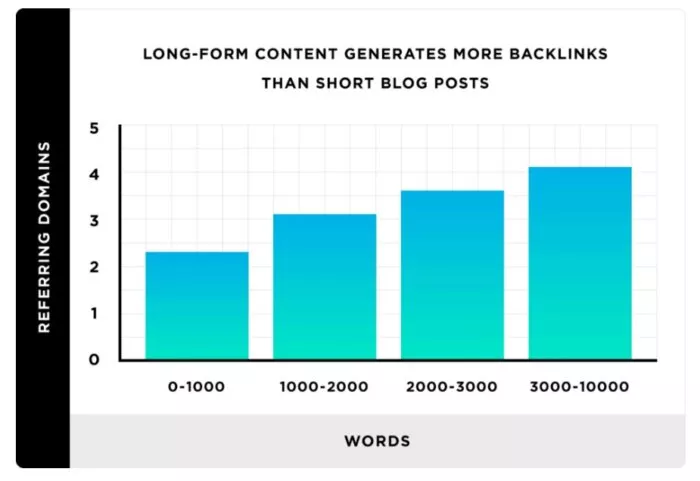
- Listicles and photo galleries also get more shares, higher page views, and better click-through rates than other formats (and ones with odd numbers in the headline do 20% better than even-numbered ones).
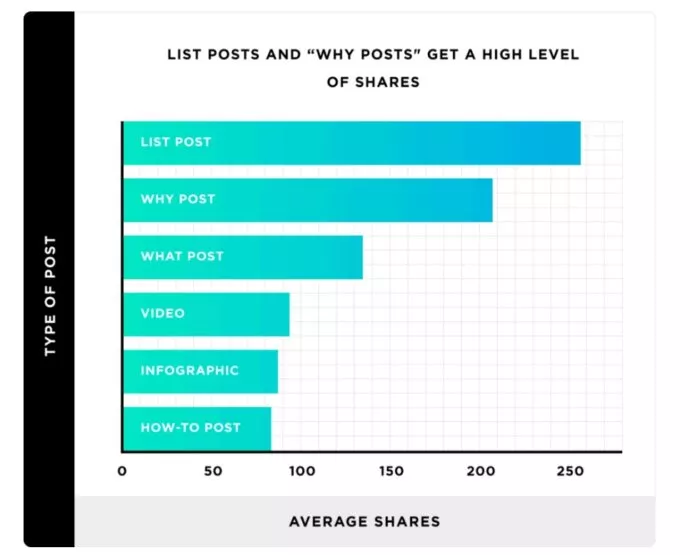
How To Create Viral Content Tip #6: Ensure There Is a Clear Opportunity To Share
Without a good reason to spread your website or your content, your website’s traffic and sign-ups will not grow.
For instance, if you write a blog and your content is extremely valuable and original for the target audience reading it, visitors will use that “Share” button floating next to the post.
For some companies, their product becomes inherently more valuable the more your friends or contacts are on it. Hence, you have to get your friends to sign-up for the service to increase its value to you.
Take Dropbox, for example.
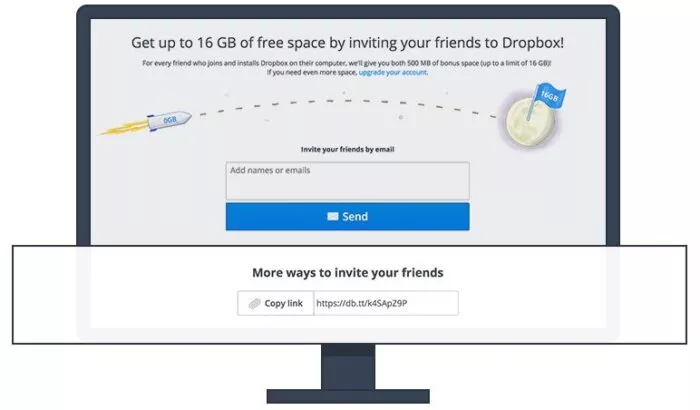
When Dropbox first started, it had a great product, but more people needed to use it to grow and be even more effective. So they gave people an opportunity to share it.
Dropbox now has over 700 million users. I guess it worked!
How To Create Viral Content Tip #7: Offer People Something Unexpected (and Simple To Understand)
You know the feeling when you see something viral… your brain gets a jolt of awareness. You take a breath and reread it, and then a little smirk creeps across your face because you know you’ve stumbled upon something cool.
Those are the emotions you’re looking to recreate with your content.
Most of the time, these types of content ideas are very simple. Most people like simplicity. In fact, I would say they crave it.
Here’s a perfect example of simple and viral:
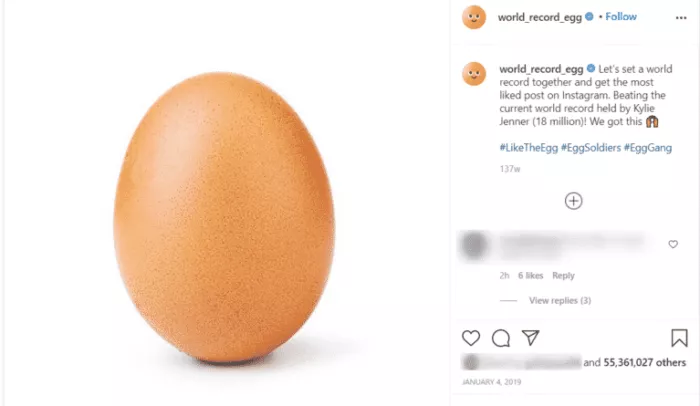
This post beat out Kylie Jenner for the most-liked on Instagram. Here’s why:
- It’s unique
- It’s engaging
- It’s funny
- It has an ambitious goal (breaking a record)
There was obviously a clear incentive for the number of shares, but it shows the power of social media:originality and simplicity. Harness that power if you can.
You have to be different to be viral. Either come up with a wholly different idea or, at the very least, have a new take on an old one.
Offer people something unexpected that snaps them out of their mindless scrolling when they see it.
How To Create Viral Content Tip #8: Evoke the Right Emotion
Your best bet to go viral is for your content to stir up feelings inside your audience.
Ideally, you want this to be a positive emotion, not a negative one. Think about how the daily news doesn’t usually go viral…
For a negatively charged piece of content to go viral, it must tap into “high-arousal” emotions, such as disgust. You’re playing with fire here, and you’ll probably get burned.
Happiness in general is what you should go for—awe, laughter, joy, and amusement.
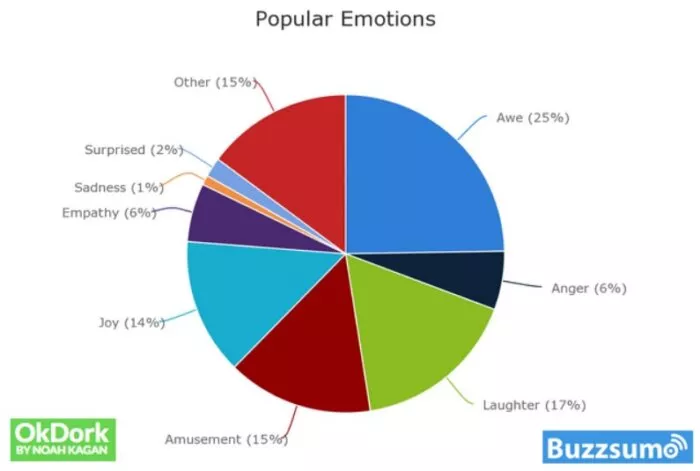
How To Create Viral Content Tip #9: Make the Person Sharing Look Smart (or Cool or Funny or Interesting)
Social media is all about making yourself look good, right? So if you want people to share your content, play off that emotion and their ego. You’re probably interested to see if your friends are interested in the same things you are, right?
There’s tons of psychology behind all this.
Sharable content is social currency. If your content makes them look clever or smart, they will pass it on to their friends and followers. Then they feel cool. They feel like they enhanced someone else’s life by sharing it.
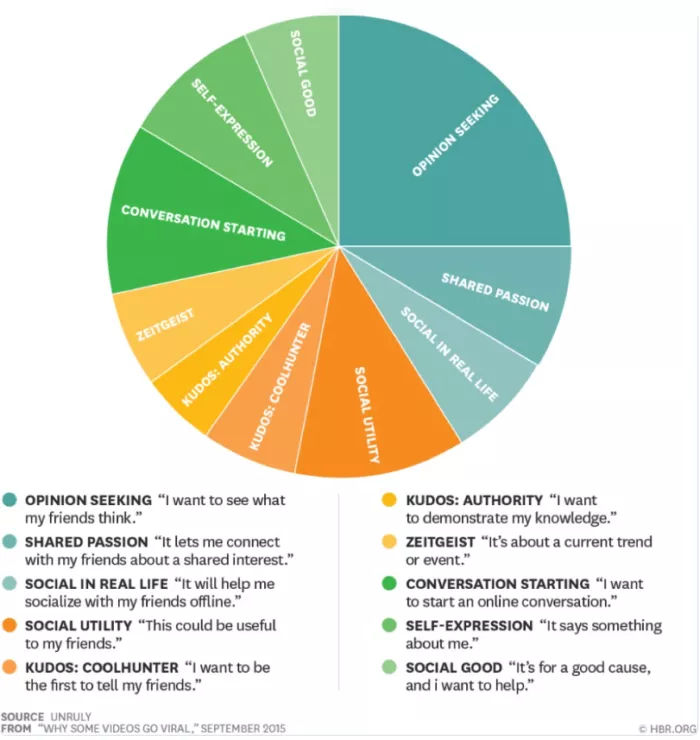
How To Create Viral Content Tip #10: Headlines Are the Ultimate Starting Point
Your content is not going viral if you don’t have a great headline. 59% of people will share an article based on a headline alone. It’s the ultimate starting point to go viral.
Backlinko says “very long” headlines (14-17 words) outperform short headlines by 76.7%:
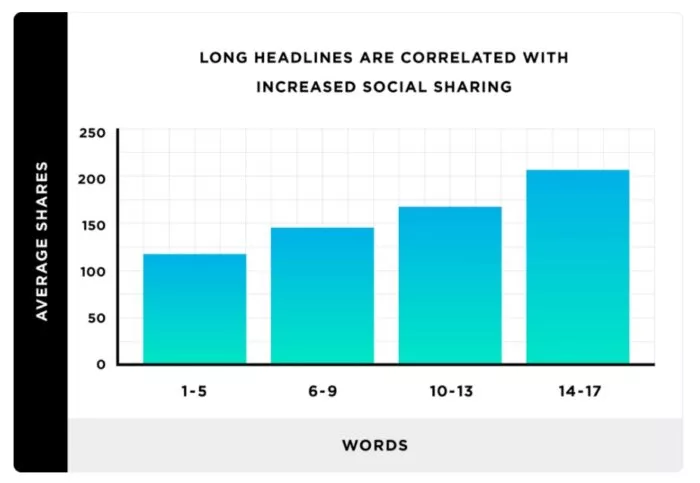
The best advice for your headline is to make it catchy, benefit-driven, and curious. Ask yourself if you would click on that headline…
Whether it’s creating viral blogs, writing newsletters and landing pages, creating striking visuals, or any other digital marketing need, we’re here to help. At Growbo.com, our pros are ready to assist you—all you need to do is delegate. Start Your $7-for-7-Days Trial Now.
How To Create Viral Content Tip #11: After Your Headline You Need a Hook
Ok so you got a great headline?
Now what?
The headline got you from casual viewer to reader. Oh no! Now you have their attention. You have a real shot at going viral. Panic sets in. What should you do?
You need a hook.
The next point of leverage is your hook, which should be very near to the top of your content. As soon as your amazing title has stopped the doom scroll, you have about 8 seconds (the average attention span of a human now) to get them to keep reading.
Your hook is the foundation of your content. It’s how you keep your audience’s attention and get them to take action. Throughout your content, keep your hook in mind. It’s what keeps your content aligned and will help keep your readers' attention.

After all, the hook is what got them reading. If you don’t fulfill your promise or abandon the hook idea, people will lose interest.
The type of hook you use will vary depending on the content medium, but less is usually more.
The graphic below shows the elements of how a good hook can grab the reader’s attention.
Tips for creating a great hook:
- Use strong, attention-grabbing language.
- Create a sense of urgency or curiosity.
- Offer a benefit or solution to your audience’s problem.
- Make your hook memorable and shareable.
- Stay true to your brand’s voice.
- Make sure your hook is relevant to your target audience.
- Keep your hook concise and to the point.
- Don’t overthink it—hooks come from emotion.
How To Create Viral Content Tip #12: Have a Visual Element
As the saying goes, “A picture is worth a thousand words.” Using visual elements in your content can capture your audience’s attention and make your message more memorable.
Images, videos, infographics, charts and graphs, memes, and GIFs are vital to make your content go viral.
Creating infographics is an excellent way to go viral. They combine images, relevance, and make the “sharer” feel and look smarter. Check out this example of an infographic from Copyblogger that has been shared over 200,000 times:

Here are some quick tips for using visual elements in your content:
- Use images and videos relevant to your topic. (Web content with visual content gets 94% more views than those without.)
- Use high-quality images and videos and make sure they are easy to understand. (Visuals communicate ideas faster than words, so use the clearest and best images and videos you can find.)
- Use them to break up your text for easier reading. (An image once every 75-100 words gets double the amount of shares.)
- Use visual elements to illustrate your points and make your content more engaging and shareable. (Content with images gets shared 2.3 times more often on Facebook, according to a Buzzsumo study of 1 million articles.)
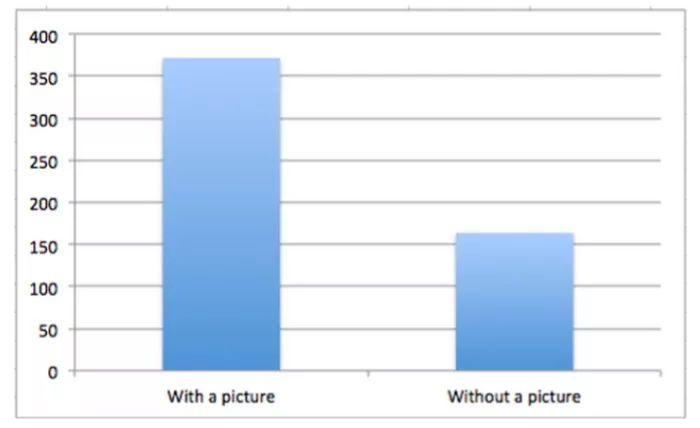
How To Create Viral Content Tip #13: Make It Readable and Digestible
At Growbo, we are a bit fanatical about the look and feel of our content.
One of the things we like to do to make copy more interesting is give it what copywriter extraordinaire Joanna Wiebe calls texture.
You may notice that some of our text is bolded. Some is italicized.
- Bullet points are always nice because they break up text and make good use of white space (good for skimability).
When we quote someone (like a customer comment), we usually indent it and italicize it and bold some words.
“The very first year that we signed up with Growbo, we saw revenue growth of 60+ percent. [Growbo] built just a 490-word description page on our website... within a couple of months, we had landed... a $35,000 contract ... I can’t recommend them enough.”
- Dave Baker | Founder and copy chief
These are good tactics to use to get more people to read your content.

And don’t forget to add images.
Making digestible content is another good idea to help go viral. Viral content is typically short and sweet. Videos tend to be 30 seconds to one minute; anything longer might lose your audience’s attention.
People have short attention spans, so make your content easy to scan with images, bullet points, and subheadings. There’s no scientific evidence on length correlating with virality. Social media posts however, have lots of data on how long they should be. See chart below.
And don’t forget to proofread your work. Even the most well-written articles can be ruined by typos and grammatical errors.
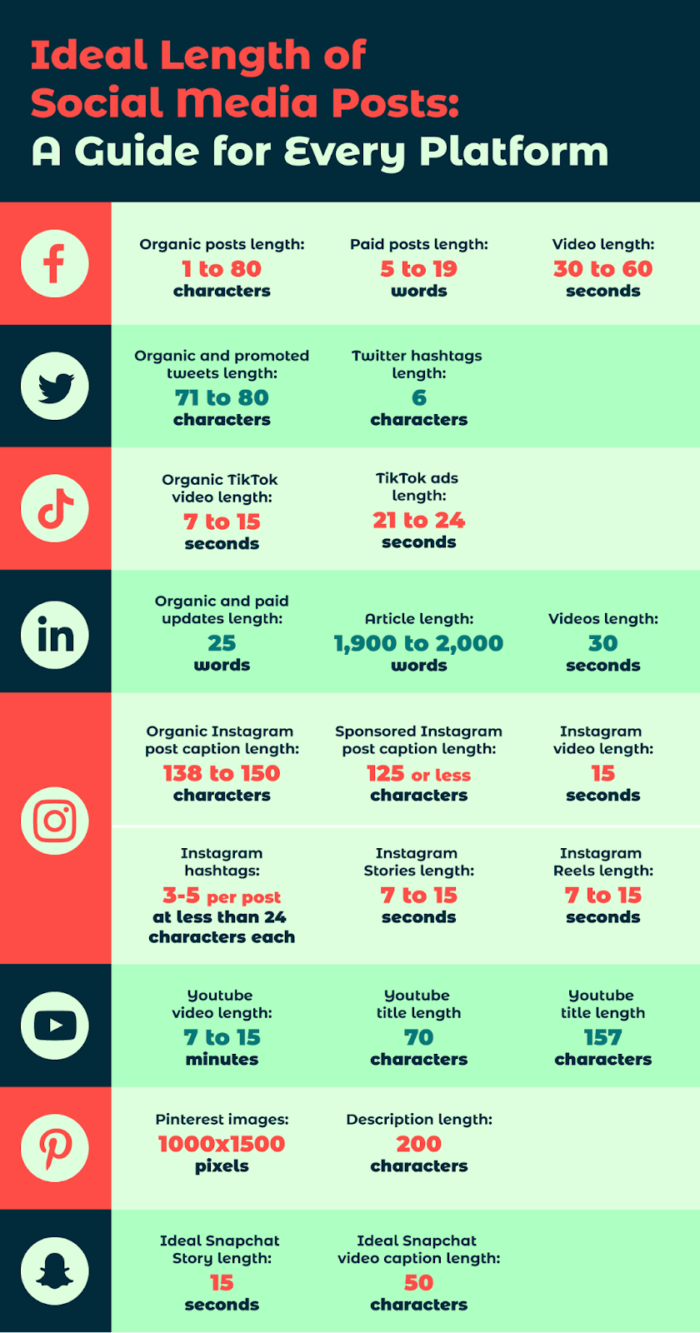
How To Create Viral Content Tip #14: Make It Relatable and Authentic
People usually only share things they understand or relate to on some level. This requires genuine caring and authenticity about the content you’re presenting.
I really try to not BS when I write content or speak on video. I feel strongly about this because I want to have an authentic brand. Plus, people are smart and they can see through your fakery. And they can see if you are trying too hard to get you to like them. Don’t do that.
It’s OK not to be perfect. Keep trying. You’ll get better. Embrace it.
According to HubSpot, on their list of most interesting and memorable content, relatable content is No. 2 for being effectively shareable (you can’t beat something funny).
Nearly 70% of consumers say authentic and relatable social media content is more important than polished, high-quality content.

People can see through over-produced content that is trying too hard. Stick to what you’re good at and go for a connection rather than showing off.
How To Create Viral Content Tip #15: “Draft” Off Something Current or Relevant
Finding what is trending right now is an excellent way to increase your chances of going viral.
In racing, cars can gain an advantage by “drafting” the car in front of them. The car in front gets all the wind resistance, allowing the car behind to save gas and have reserve power to get out in front.
If you find a topic that is trending, you can jump on the coattails of the trend.
AI is a perfect example of people drafting on a hot topic. Have you seen how many courses, software, headlines, articles, videos, and content pieces are out there on it?
“Will AI Take My Job…?” Fear and relevance are a powerful combination.

I’d like to say they’re not going viral because I am still skeptical in this space about whether it’s a bubble or not… But ?lots of people are making a lot of money off viral AI content right now because it’s relevant.
Social Media Today says that 82% of people like reading brand content when it’s relevant.
And it doesn’t have to be doom and gloom that “breaks the internet.”
Remember when Ellen’s photo at the Oscars broke Twitter?

That went viral during the show and immediately afterward. Social media trends move quickly and standards keep getting higher, so take advantage when possible.
You can also make use of holidays and special events. Think Christmas, Valentine’s Day, Halloween, the Fourth of July, back to school, etc.
Going viral, as we have said, is all about capturing emotions. Your Halloween clips probably won’t get shared much in July… but Christmas videos in early December could double your revenue.

Use tools like Buzzfeed’s trending section, Buzzsumo, and search for the most shared web content on a specific topic. Also, try the most “upvoted” topics on Reddit, and Google Trends to find out what’s hot right now. (Do people still say “hot”?)
How To Create Viral Content Tip #16: Calculate Your Viral Coefficient
There’s no way to know if your website is growing virally unless you pay attention to the rate at which people share your content or invite others to your website.
One recommendation is to calculate “viral coefficient.” This is the number of invitations sent out per visitor on your website multiplied by the sign-up rate. It measures how well your content spreads through word-of-mouth and referrals. You can read more about the viral coefficient here.
Find your magic numbers and aim to meet or beat them.
Here’s a visual representation of how much engagement it takes to go viral:
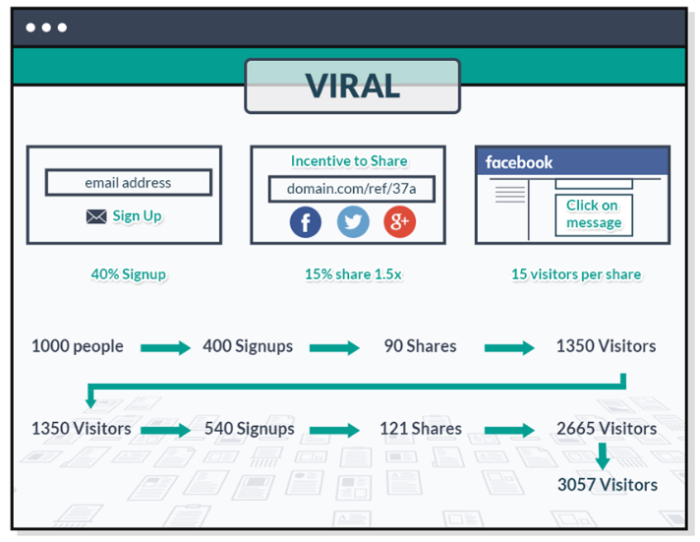
You will also want to track certain key performance indicators (KPIs) to see if you have reached viral status with your marketing campaign. Here are some of the best tracking tools:
- Google Analytics: This free tool provides all sorts of free information about your site visitors, backlinks, and more.
- Buzzsumo: Buzzsumo tracks content across all social networking sites and then ranks it by the number of shares.
- Moz’s Link Explorer: Link Explorer measures your backlinks, most valuable pages, linking domains, and anchor text—everything you need to go viral.
- LinkTrackr: LinkTrackr tells you how often people worldwide have shared your content.
And when you get all this information, here are the main KPIs you want to track and evaluate:
- Website Traffic
- Cost per Lead
- Engagement
- Marketing Qualified Leads
- Conversion per Activity
- Revenue Contributed
How To Create Viral Content Tip #17: Failure Is the Secret To Success

Not many people create viral content on their first try. Most likely, you will find increased success as you continue creating.
Need some examples?
- It took Thomas Edison 10,000 tries to invent the lightbulb. That went pretty viral afterwards.
- Arriana Huffington was rejected by 36 publishers. She now owns the HuffPost (which creates viral content) and Thrive Global, and has written 15 books.
- Bill Gates’, Oprah Winfrey’s, and Walt Disney’s first careers were disasters. They created tons of viral content.
Once you get some viral content action, evaluate what worked and use that data to create your next (hopefully) viral content. Here are some things to consider:
- How can you create more viral content that reinforces your brand message?
- Was there a clear campaign strategy in place with a defined goal?
- Did you misread your audience’s likes and dislikes or target them on the wrong platform?
- Did you check feedback and comments?
- Was everything aligned? (Check out the Law of Alignment.)
Then refine your process by experimenting with new ideas. Add or remove sharing-related features, change the wording of your invitation process, or remove steps from the viral loop. With each change, go back and study the data to see if the rate of sharing or sign-ups has increased.
Keep iterating until you find a process that works for you and that your audience makes viral.
Conclusion
Some companies don’t have the time (or the talent) to create viral articles. We can help. At Growbo.com, our sole purpose is to help you grow your company as fast as possible. Take the first step toward success with our expert assistance. Start Your $7-for-7-Days Trial Now.
In today’s digital age, one of the best ways to grow your brand fast is with social media content. If you manage you catch lightning in a bottle and go viral with one of your ideas, you can ride that success all the way to the bank.
Whether your goal is to get a few hundred likes or a million shares, I hope you have learned a few new ideas for creating content that goes viral.
Let’s do a quick rundown of everything we covered:
- Go Viral Tip #1: Use what has already been done and copy first — then create something original.
- Go Viral Tip #2: Go for viral marketing rather than the viral loop.
- Go Viral Tip #3: Create content that aligns with your target audience.
- Go Viral Tip #4: Using tools will help you create viral content faster.
- Go Viral Tip #5: Choose a format that works best for you and your audience.
- Go Viral Tip #6: Make sure people can easily share your content.
- Go Viral Tip #7: Offer people something they aren’t expecting but can understand it.
- Go Viral Tip #8: Evoke the right emotion to get the right reaction.
- Go Viral Tip #9: Make people look better by creating something worth sharing.
- Go Viral Tip #10: You need a great headline or no one will click.
- Go Viral Tip #11: Keep them reading with a fantastic hook.
- Go Viral Tip #12: Everyone loves visuals.
- Go Viral Tip #13: Make it readable and digestible.
- Go Viral Tip #14: Make it relatable and genuine. Be yourself.
- Go Viral Tip #15: Hop on a current trend’s bandwagon.
- Go Viral Tip #16: Know your viral coefficient.
- Go Viral Tip #17: It’ll probably take you a few tries.
I’d love to know if you have had any success getting your marketing content to go viral. Did you use any specific tactics that aren’t on this list? Leave your ideas or thoughts in the comments section below.
And if you want to share this article and help it go viral, I would be okay with that, too.
Until next time…
Keep Growin’, stay focused.

Image Bibliography
- https://ahrefs.com/blog/skyscraper-technique/
- https://aelieve.com/rankings/websites/category/news-media/best-viral-sites/
- https://referralrock.com/blog/viral-loop/
- https://referralrock.com/blog/viral-marketing/
- https://www.youtube.com/watch?v=KWqw5SpITg8
- https://okdork.com/why-content-goes-viral-what-analyzing-100-millions-articles-taught-us/
- https://www.sociallysorted.com.au/survey-your-audience/
- https://buffer.com/resources/best-time-to-post-on-social-media/
- https://backlinko.com/content-study
- https://www.upviral.com/blog/incentive-to-get-people-sharing
- https://socialbee.com/wp-content/uploads/2021/09/world-record-egg-768x445.png
- https://www.convert.com/blog/optimization/optimize-youtube-videos-viral-holidays/
- https://okdork.com/why-content-goes-viral-what-analyzing-100-millions-articles-taught-us/
- https://www.decaturindustrial.com/dont-forget-test-notes/
- https://burstofimagination.com/12-elements-of-effective-marketing-hooks/
- https://www.easel.ly/blog/case-study-infographics-website-traffic/
- https://blog.hootsuite.com/ideal-social-media-post-length/
- https://www.kron4.com/news/national/video-of-grinch-scaring-kids-during-holiday-photo-shoot-goes-viral/
- https://marieennisoconnor.medium.com/how-can-i-make-my-content-go-viral-391165017971
- https://www.alexanderjarvis.com/what-is-viral-coefficient-what-is-the-formula-and-why-it-is-important/
- https://wellquo.com/winston-churchill-quotes-for-success/













